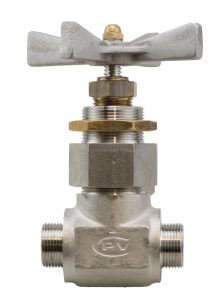How to Avoid Cavitation
Cavitation Solutions for Globe Valves
Cavitation, the sudden vaporization, and condensation of a liquid downstream of a valve are common in control valves, but it can be avoided.
 When the flow of a liquid is restricted as it passes through the valve seat, a low-pressure area is formed on the other side (downstream) of the vena contracta. When that local pressure is lower than the vapor pressure of the fluid, it flashes or vaporizes forming bubbles. These bubbles continue downstream as the pressure returns to normal.
When the flow of a liquid is restricted as it passes through the valve seat, a low-pressure area is formed on the other side (downstream) of the vena contracta. When that local pressure is lower than the vapor pressure of the fluid, it flashes or vaporizes forming bubbles. These bubbles continue downstream as the pressure returns to normal.
The normalizing or increasing pressure smashes the bubbles causing violent implosions. These implosions, or cavitation, can cause a lot of damage to the interior of the valve and pipes.
The sound of the imploding bubbles, which is easily recognizable by anyone who’s heard it, sounds like rocks flowing through the pipes. Just the sound and mechanical vibration from the implosions cause plenty of damage.
Additional surface damage is caused by the shock wave of the bubble as it implodes, creating pits on the areas of a plug that form the seal; and causing it to leak.
Cavitation causes a number of problems. Some of the potential consequences of cavitation in a globe or control valve are:
- Erosion of valve components—seat, plug, and body—and the resulting need for replacement.
- Intensified effects of corrosion where corrosion is a factor.
- Strong vibrations and loud noise that extend well beyond the local area causing stress on the valve and significantly reducing efficiency.
- Changes in flow due to the resultant leakage.
- Destruction of the valve.
- Stopping of operations.
Factors That Increase Cavitation
- Higher drops in pressure cause more cavitation T-‐type globe valves with their 90° turns create a higher pressure drop, so they are even more susceptible to cavitation damage.
- Leakage of the fluid increases the likelihood of cavitation.
- The larger the valve, the more severe the cavitation is likely to be.
- The higher the velocity of the flow, the higher the change in pressure will be resulting in more cavitation.
How to Reduce Cavitation
Cavitation isn’t always inevitable. There are ways to reduce or eliminate the amount of cavitation and the damage it causes.
First off, harder materials stand up better to cavitation damage. Some trim materials that are more resistant to cavitation are Stellite and 13Cr martensitic stainless steels.
Lowering the operating temperature will sometimes be enough to reduce the vapor pressure to the point where cavitation doesn’t occur. If the process can withstand an even slightly lower temperature, this may be a good solution.
An increase in both the upstream and downstream pressure could lessen or eliminate cavitation as well. Where it’s applicable, having the valve closer to the pump may increase the pressure on both sides, leading to less cavitation.
Another possible solution is to allow flashing to occur but to stop the pressure recovery or increase that causes the cavitation. A slight increase in operating temperature can help.
Multi-‐step trim design allows the pressure to decrease in stages. A more gradual decrease in pressure reduces or eliminates the risk of cavitation.
As globe valve manufacturers, CPV’s customer service team is here to help you select the best valve options for your operations. Our valves and fittings are known for their state-‐of-‐the-‐art design, high quality, safety and reliability and are manufactured with your safety in mind.
